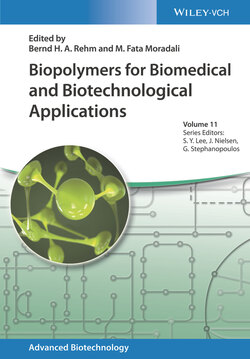Читать книгу Biopolymers for Biomedical and Biotechnological Applications - Группа авторов - Страница 23
2.2 Functional Properties and Applications of Microbial Polysaccharides
ОглавлениеThe main components of microbial polysaccharides are carbohydrates. Glucose, galactose, and mannose are the most common monomers, but other neutral sugars such as rhamnose, arabinose, and fucose and some uronic acids and amino sugars are also frequently found in such biopolymers. In addition to carbohydrates, microbial polysaccharides may also contain several organic acyl substituents in their molecular chains, such as ester‐linked groups and pyruvate ketals [4,10,11]. Given this diversity of polysaccharides' components that may include different sugar monomers as well as several noncarbohydrate groups, there is a wide range of possible molecular structures for these macromolecules. Consequently, microbial polysaccharides can display distinct physical and chemical properties.
The possible multiple combinations of monomeric units in polysaccharide molecules, along with the stereospecificity of glycosidic linkages (α or β anomers), lead to very complex chemical structures ranging from linear homopolysaccharides to highly branched heteropolysaccharides. Molecular mass distribution, chemical composition, and structure, namely, the presence of ionizable groups that confer the polysaccharides a polyelectrolyte behavior, greatly affect their properties, as well as the nature and number of intra‐/intermolecular interactions. Moreover, the properties of polysaccharides may be altered using mixtures with other components, for example, by blending with other polymers or adding salts and crosslinking agents.
Some examples of microbial polysaccharides that have been developed at the industrial level and are currently commercialized include xanthan, a heteropolysaccharide composed of glucose, mannose, glucuronic acid, pyruvate, and acetate, produced by Xanthomonas sp., which is used mainly in food, pharmaceutical, and personal care products and in oil recovery [12]; dextran, a water‐soluble glucan secreted by lactic acid bacteria of the genera Leuconostoc, Streptococcus, Weissella, Pediococcus, and Lactobacillus, which is used in food, cosmetic, and medical applications [13]; hyaluronic acid (HA), a linear polymer of glucuronic acid and N‐acetylglucosamine units, produced by Streptococcus zooepidemicus that is used in cosmetics, pharmaceuticals, and medicine [14]; pullulan, a linear α‐glucan secreted by the black yeast‐like Aureobasidium pullulans that is used as a thickening agent and edible coating [6,15]; and scleroglucan, a water‐soluble β‐glucan secreted by the plant pathogen Sclerotium sp. that is used in applications such as enhanced oil recovery, food, cosmetic, and pharmaceutical [16]. Additionally, there are a growing number of recent reports on newly discovered polysaccharides, with novel molecular structures, obtained from species belonging to different taxonomic groups, which display numerous biological activities (Tables 2.1 and 2.3) and may turn into novel applications.
Table 2.1 Examples of polysaccharides produced by bacteria and fungi displaying biological activity.
| Microbial source | Polysaccharide | Biological activity | References |
|---|---|---|---|
| Bacteria | |||
| Acetobacter xylinum NCIM2526 | Fructan | Antioxidant; anti‐inflammatory | [17] |
| Bacillus licheniformis T4 | Fructo‐fucan | Anti‐cytotoxic; antiviral | [18] |
| Bacillus tequilensis PS21 | Heteropolysaccharide (xylose, glucose, ribose, rhamnose, galactose) | Antioxidant | [19] |
| Enterobacter A47 | Heteropolysaccharide (fucose, glucose, galactose, glucuronic acid, acetate, succinate, pyruvate) | Antioxidant | [20] |
| Enterobacter cloacae Z0206 | Heteropolysaccharide (fucose, glucose, galactose, glucuronic acid) | Antioxidant; antidiabetic; hypolipidemic | [21] |
| Enterococcus faecium K1 | Heteropolysaccharide (mannose, glucose, galactose) | Hypocholesterolemic; antibiofilm; antioxidant | [22] |
| Lactobacillus sp.Ca6 | α‐(1,6)‐Glucan | Antioxidant; antibacterial; wound healing | [23] |
| Lactobacillus casei SB27 | Heteropolysaccharide (galactose, glucose) | Antitumor | [24] |
| Lactobacillus gasseri FR4 | Heteropolysaccharide (glucose, mannose, galactose, rhamnose, fucose) | Antioxidant; antimicrobial | [25] |
| Lactobacillus kefiranofaciens DN1 | Heteropolysaccharide (mannose, arabinose, glucose, galactose, rhamnose) | Antibacterial | [26] |
| Lactobacillus plantarum BR2 | Glucomannan | Antioxidant; antidiabetic; hypocholesterolemic | [27] |
| Pediococcus parvulus 2.6 | β‐(1,3)‐Glucan | Anti‐inflammatory; probiotic | [28] |
| Pseudoalteromonas sp. S‐5 | Heteropolysaccharide (mannose, glucose, galactose) | Anticancer | [29] |
| Fungi | |||
| Antrodia cinnamomea | Heteropolysaccharide (fucose, glucosamine, galactose, glucose, mannose, sulfate) | Anticancer | [30] |
| Aspergillus sp. Y16 | Galactomannan | Antioxidant | [31] |
| Candida utilis | Glucomannan | Antiarthritis; antioxidant | [32] |
| Diaporthe sp. | β‐Glucan | Antitumor | [33] |
| Fusarium equiseti ANP2 | Glucomannan | Antioxidant | [34] |
| Fusarium solani SD5 | Rhamnogalactan | Anti‐inflammatory; anti‐allergic | [35] |
| Trichoderma kanganensis | Heteropolysaccharide (mannose, galactose, glucose, glucuronic acid) | Anticancer; antioxidant | [36] |
Biopolymers of microbial origin have been studied lately due to their improved properties and easy production when compared with other natural polymers [4,78]. Microorganisms usually have higher growth rates than algae and plants, and their production processes can easily be manipulated to improve yields and productivity [79]. Moreover, the production process is not climate or seasonal dependent and can rely on the use of low‐cost by‐products or wastes as raw materials [80]. Microbial polysaccharides have unique features and properties that make them suitable to a wide range of applications. More specifically, these biopolymers have been extensively used in food, pharmaceutical, medical, and cosmetic products due to their unique performances as thickening, stabilizing, and binding agents. Some of these biopolymers (e.g. bacterial alginate, gellan, FucoPol) can also have intermolecular interactions that could result in polymeric matrices, allowing the physical manipulation of polysaccharides into structured materials such as gels (e.g. hydrogels) or films that could be used in biomedical applications [4,81]. Adding to this property, the ability of polysaccharides to interact with different inorganic materials represents an important feature for the encapsulation of bioactive substances (e.g. pharmaceuticals for their controlled release) and for the incorporation of nanostructures (such as carbon nanotubes or metallic nanoparticles [MNPs]) to produce enhanced biomaterials (with synergetic conductive or magnetic properties, respectively) [82].
